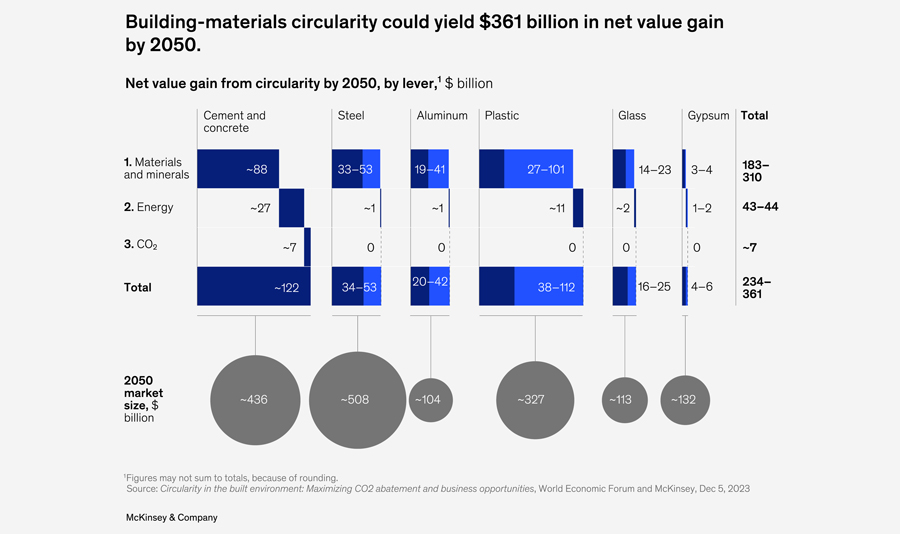How circular practices in construction can drive economic & environmental benefits
By Retail4Growth Bureau | May 28, 2025
According to a McKinsey report, circular principles could abate 13 percent of the built environment’s embodied carbon emissions in 2030 and nearly 75 percent in 2050 and that minimizing waste and maximizing utility could add $360 billion in net value gain by 2050.

A new report by McKinsey Quarterly throws interesting light on the business implications of circularity and sustainable practices in the context of built environment. The report says that minimizing waste and maximizing utility could add $360 billion in net value gain by 2050 and this poses much significance in the area of retail architecture/store design and construction.
The report sets the context by highlighting some important facts:
- The built environment is responsible for almost 40 percent of global energy-related CO2 emissions and produces about one-third of the world’s waste
- Over one-quarter of global CO2 emissions come from building operations alone.
- Only 1 percent of materials from building demolitions are reused, the rest of the concrete, steel, and other valuable materials become waste, even while new supplies of these same materials are generated for use in other buildings.
- Circular principles could abate 13 percent of the built environment’s embodied carbon emissions in 2030 and nearly 75 percent in 2050.
Describing the built environment as being one of the largest global industries, with a total value of $14 trillion (13 percent of global GDP), of which real estate composes almost $4 trillion, the report says the sector accounts for 12 percent of global employment and is experiencing substantial volume growth driven by rapid urbanization, with global construction on a path to $22 trillion in total value by 2040. But as it highlights, the built environment also generates more global emissions than any other sector , and suggests that circularity as a way forward to address the environmental challengs and also drive business benefits.
As the report points out, “By recirculating used materials through harvesting, recertifying, and testing, construction projects can be delivered at a lower cost than by using virgin materials with equivalent performance criteria. Circular practices can accelerate project timelines by minimizing the total work required for an equivalent outcome, mitigating labor productivity challenges by reducing the impact of resource and manufacturing lead times.”
Circularity in building materials
While circular practices can be applied across the construction and architectural processes, the report in particular highlights the benefits of circularity when it comes to building materials. It says,substituting virgin materials with recycled construction and demolition waste is crucial to circularity in the built environment. It further lists down some important facts when it comes to major building materials:
- Concrete and cement: Contribute 30 percent of building-material-related CO2 emissions. Circular strategies such as enhanced recarbonation and the mineralization of aggregates from concrete waste or other waste materials can abate 96 percent of embodied CO2 emissions from cement by 2050. According to the report, circular approaches help extend the life of concrete structures and reduce waste by using materials that would otherwise be discarded, resulting in an up to 80 percent reduction of up-front greenhouse gas emissions. “Additionally, industrial by-products such as fly ash, pozzolans, and slag can be reused as cementitious materials, helping to reduce carbon emissions and create new revenue streams,” it adds. It also says that the estimated net value gain from circularity in cement and concrete is $10 billion in 2030 and $122 billion in 2050.
- Construction steel: Reportedly early 25 percent of metal ores were recycled in 2023, compared with only 3 percent of fossil-fuel materials, such as coal, natural gas, and oil, but reusing or repurposing whole construction steel components is currently only done at a small scale, which could be expanded. The report estimates that the net value gain from circularity in steel would be $27 billion in 2030 and $61 billion in 2050
- Construction aluminum: According to the report, adopting alternative fuels in the manufacturing process, designing for reuse, and increasing recycled-material use can reduce aluminum-related CO2emissions by up to 89 percent by 2050 with the estimated net value gain from circularity projected at $16 billion to $31 billion in 2030 and $20 billion to $42 billion in 2050.
The report further highlights the benefits of circularity with other construction materials such as construction plastics (estimated net value gain from circularity at $7 billion to $20 billion in 2030 and $38 billion to $112 billion in 2050), flat glass (estimated net value gain from circularity pegged at $3 billion in 2030 and $16 billion to $25 billion in 2050), and Gypsum wallboards (estimated net value gain from circularity at $1 billion in 2030 and $4 billion in 2050).
Materials are only part of a sustainable and circular approach to construction, architecture and design, but central to the McKinsey report is the fact that circularity offers a transformative approach to making the built environment more sustainable and economically resilient. “By embracing circular practices, the industry can create substantial economic value, enhance resource efficiency, and drastically reduce the environmental impacts associated with the built environment,” it says.
Summing up, the report adds, “To accelerate the circular transition, stakeholders can collaborate, leverage technology, and plan for circularity from the earliest stages of developing buildings. Integration, partnerships, and standardized circular materials, along with strong business models, are essential to support long-term sustainability.”
There are some some global examples in the retail sector of sustainable and circular practices. For example, given that 75% of all areas covered by glaciers have melted due to rising temperatures and hundreds of tonnes of plastic being produced daily, Spanish architectural solutions company Nagami skillfully 3D-printed recycled plastic to mimic melting glaciers in Spanish boutique Ecoalf with walls, shelves and display tables made from 3.3 tonnes of repurposed plastic waste sourced mainly from hospitals and utilized to craft translucent surfaces.
Similarly with an aim to reduce waste in the beauty industry, change consumer behavior as well as inspire them, Nina+Co reportedly used salvaged materials and biotextiles for Big Beauty’s first store in London.
Then there’s London design studio JamesPlumb, which intertwined hand woven bulrush shelves with earthy hemp accents for the interiors of Aesop store in Cambridge.The Australian skincare and cosmetics brand’s store features oversized, textured shelves made from freshwater bulrush plants that are locally sourced and handwoven by rush weaver Felicity Irons of Rush Matters. There are more such examples that demonstrate how it’s possible to balance aesthetics, brand objectives and environmental responsibility. But it would need the involvement of all stakeholders.
As the McKinsey report says, “Large-scale adoption of circularity will ultimately require a sea change in mindsets, collaboration across the sector, and bold, creative thinking about new business models and possibilities by all stakeholders in the built environment. Accelerating this new future can begin immediately, with each individual step in a circular direction.”









Comments